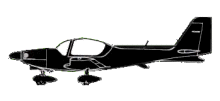
ASN Wikibase Occurrence # 137194
This information is added by users of ASN. Neither ASN nor the Flight Safety Foundation are responsible for the completeness or correctness of this information.
If you feel this information is incomplete or incorrect, you can submit corrected information.
| Date: | Tuesday 29 June 2004 |
| Time: | 16:50 |
| Type: |  Grob G 115E Tutor |
| Owner/operator: | Royal Air Force (RAF) |
| Registration: | G-BYXJ |
| MSN: | 82170/E |
| Year of manufacture: | 2001 |
| Engine model: | Lycoming AEIO-360-B1F |
| Fatalities: | Fatalities: 0 / Occupants: 2 |
| Aircraft damage: | Minor |
| Location: | 4.5 nm Southwest of Salisbury, Wiltshire -
 United Kingdom United Kingdom
|
| Phase: | Manoeuvring (airshow, firefighting, ag.ops.) |
| Nature: | Military |
| Departure airport: | Boscombe Down Wiltshire (EGDM) |
| Investigating agency: | AAIB |
| Confidence Rating: |
The aircraft was carrying out a short sequence of aerobatic manoeuvres at the end of an uneventful navigation training exercise. The weather was fine with a surface wind of 210 degrees/12 knots, visibility of 35 km with a few clouds at 2,300 feet and broken cloud at 25,000 feet.
After a climb to FL50, using high RPM and full power, the instructor completed the 'HASELL' checks, selected 2,500 RPM and confirmed that the auxiliary fuel pump was OFF and that the fuel was balanced between the two wing tanks. After a clearing 'Wing Over' to the right the aircraft completed a loop at 130 knots, flew level briefly and then entered a '1/2 Cuban', climbing at 130 knots with a 60 degrees nose-up attitude. When the airspeed reduced below 100 knots, full back control column and full left rudder was applied. The aircraft snap rolled left through 180 degrees and was stabilised inverted in the climb before being 'pulled through' to the horizon.
As the aircraft levelled, at approximately 120 knots with full power set, there was a loud bang accompanied by extreme vibration. The instructor saw debris passing the canopy and could feel airflow entering the cockpit. His immediate thought was that his aircraft had been involved in a midair collision. As he transmitted a 'Mayday' call he was aware of the canopy moving backwards and then detaching; neither occupant had touched the canopy latching system.
The instructor could see that the propeller blades were damaged but the resultant vibration was such that he could not read the cockpit instruments. As the engine was shut down the vibration increased but then stopped. When the propeller blades were stationary it was possible to see that one appeared to be missing and one was badly damaged. Oil was also visible on the right windscreen.
The instructor had initially considered abandoning the aircraft but with the vibration stopped he now elected to carry out a forced landing. He was familiar with the area and able quickly to identify a suitable field that he had used previously in practice exercises. Passing through his planned 'High Key' position, he completed his 'Forced Landing' checks and informed ATC of his present position and intention to land. The aircraft touched down, in a field in standing crop, at approximately 60 knots.
On the ground, the nose started yawing to the right and the aircraft began sliding to the left. The left gear collapsed and the aircraft came to rest after a ground roll of about 50 metres. The crew members were uninjured and able to vacate the aircraft without difficulty.
Aircraft recovered, repaired, and returned to service
Accident investigation:
 |
|
Sources:
1. MoD Board of Inqury Report: http://web.archive.org/web/20111206015544/[LINK NOT WORKING ANYMORE:http://www.dasa.mod.uk/modintranet/publications/aircraftAccidents/accidentsindex.htm]l
2. AAIB; https://assets.publishing.service.gov.uk/media/5422eb12ed915d137400004f/G-BYXJ_4-05.pdf
3. CAA: https://siteapps.caa.co.uk/g-info/rk=BYXJ
Revision history:
| Date/time | Contributor | Updates |
|---|---|---|
| 23-Sep-2011 02:18 | Uli Elch | Updated [Aircraft type, Cn, Operator, Location, Phase, Damage, Narrative, Plane category, ] |
| 24-Nov-2012 13:11 | Dr. John Smith | Updated [Time, Total fatalities, Total occupants, Other fatalities, Location, Phase, Departure airport, Source, Embed code, Damage, Narrative] |
| 24-Nov-2012 13:13 | Dr. John Smith | Updated [Embed code, Narrative] |
| 03-Aug-2016 23:47 | Dr.John Smith | Updated [Source, Narrative] |
Corrections or additions? ... Edit this accident description
The Aviation Safety Network is an exclusive service provided by:


 ©2024 Flight Safety Foundation
©2024 Flight Safety Foundation